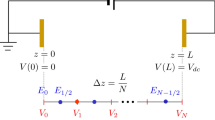Abstract
A general system of equations for a corona discharge has been derived and reduced to a dimensionless form using the methods of the similarity and dimension theory. Criteria and conditions for the similarity of the processes occurring during a corona discharge have been determined. Formulas for free space-charge density have been derived; the classical structure of the current-voltage characteristic for an arbitrary system of electrodes has been confirmed by different methods: using the theory of similarity, analyzing self-similar solutions, approximating the field distribution, and averaging the equation for the current density with respect to the volume of the interelectrode gap. It has been shown that the quadratic pattern of the current-voltage characteristics of the corona discharge results from the linear dependence of the electric field intensity and the linear threshold dependence of the density of free space carriers on the voltage.
Similar content being viewed by others
References
Proceedings of 16th IEEE International Conference on Dielectric Liquids ICDL, Poitiers, 2008.
Sovremennye problemy elektrofiziki i elektro-gidrodinamiki zhidkostei (Modern Problems of Electrophysics and Electrohydrodynamics of Liquids) (Proc. X Int. Sci. Conf., St. Petersburg, 2012), St. Petersburg: SOLO, 2012.
Basov, A.M., Bykov, V.G., Laptev, A.V., and Fain, V.B., Elektrotekhnologiya (Electrotechnology), Moscow: Agropromizdat, 1985.
Tanasescu, F.T., Bologa, M., Cramariuc, R., Bologa, A., and Cramariuc, B., Electrotehnologii. Protectia mediului, procesarea de materiale si control nedistructiv (Electrotechnology: Environmental Protection, Material Processing, and Nondestructive Testing), Bucharest: AGIR, 2011.
Ming-Wei, Li., Zheng, Hu., Xi-Zhang, Wang., Quing, Wu., and Yi, Chen., Synthesis of carbon nanowires using dc pulsed corona discharge plasma reaction, J. Mater. Sci., 2004, vol. 39, no. 1, pp. 283–284.
Ming-Wei, Li., Zheng, Hu., Xi-Zhang, Wang., Quing, Wu., and Yi, Chen., Low-temperature synthesis of carbon nanotubes using corona discharge plasma reaction at atmosphere pressure, J. Mater. Sci. Lett., 2003, vol. 22, no. 17, pp. 1223–1224.
Salvermoser, M. and Murnick, D.E., Efficient, stable, corona discharge 172 nm xenon excimer light source, J. Appl. Phys., 2003, vol. 94, no. 6, pp. 3722–3731.
Lo, S.-Y., Lobo, J.D., Blumberg, S., Dibble, T.S., Zhang, X., Tsao C-C., and Okumura, M., Generation of energetic He atom beams by a pulsed positive corona discharge, J. Appl. Phys., 1997, vol. 81, no. 9, pp. 5896–5905.
Raizer, Yu.P., Fizika gazovogo razryada (Gas Discharge Physics), Moscow: Nauka, 1992.
Vereshchagin, I.P., Levitov, V.I., Mirzabekyan, G.Z., and Pashin, M., Osnovy elektrodinamiki dispersnykh system (Fundamentals of Electrodynamics of Disperse Systems), Moscow: Energiya, 1974.
Tokarev, A.V., Koronnyi razryad i ego primenenie (Corona Discharge and Its Application), Bishkek: Izd. Kyrg.-Ross. Slavyan. Univ., 2009.
Samusenko, A.V. and Stishkov, Yu.K., Elektrofizicheskie protsessy v gazakh pri vozdeistvii sil’nykh elektricheskikh polei (Electrophysical Processes in Gases under the Action of Strong Electric Fields), St. Petersburg: Izd. S.-Peterb. Gos. Univ., 2011.
Bologa, A. and Paur, H.-R., Corona discharge in gaseous phase—study and applications, Abstracts of the 6th International Conference on Materials Science and Condensed Matter Physics, Chisinau, 2012, p. 258.
Bologa, A., Paur, H.-R., Seifert, H., and Woletz, K., Influence of gas composition, temperature and pressure on corona discharge characteristics, Int. J. Plasma Environ. Sci. Technol., 2011, vol. 5, no. 2, pp. 110–116.
Bologa, A., Paur, H.-R., Seifert, H., and Woletz, K., Abstracts of the European Aerosol Conference, Granada, 2012. http://www.eac2012.com/EAC2012Book/files/694.pdf.
Baldanov, B.B., A source of weakly ionized nonequilibrium plasma based on a pulse-periodic regime of a negative corona discharge in an argon stream, Cand Sci. (Eng.) Dissertation, Ulan-Ude: Vost.-Sibir. Gos. Tekhnol. Univ., 2004.
Karal’nik, V.B., Numerical simulation of unsteady processes in low-current gas discharges, Cand Sci. (Phys.-Math.) Dissertation, Troitsk, 2007.
Dandaron, G.-N and Baldanov, B.B., Features of ignition of a negative corona in an electropositive gas flow, Inzh. Fiz., 2007, no. 3, pp. 30–32.
Eliasson, B. and Kogelschatz, U., Modeling and applications of silent discharge plasmas, IEEE Trans. Plasma Sci., 1991, vol. 19, no. 2, pp. 309–323.
Shuaibov, A.K., On conditions of contraction of a multielectrode corona discharge in He/Ar, Kr, Xe mixtures, Pis’ma Zh. Tekh. Fiz., 1999, vol. 25, no. 17, pp. 90–94.
Sedov, L.I., Metody podobiya i razmernosti v mekhanike (Similarity and Dimension Methods in Mechanics), Moscow: Nauka, 1977.
Townsend, J.S., Die Ionisation der Gase. Handbuch der Radiologie, Stuttgart: Hirzel, 1920, bd. 1.
Loeb, L.B., Fundamental Processes of Electrical Discharge in Gases, Literary Licensing, LLC, 2013.
Kaptsov, N.A., Koronnyi razryad i ego primenenie v elektrofil’trakh (Corona Discharge and Its Application in Electric Filters), Moscow-Leningrad: Gosizdat Tekh.-Teor. Literat., 1947.
Author information
Authors and Affiliations
Corresponding author
Additional information
Original Russian Text © F.P. Grosu, An.M. Bologa, M.K. Bologa, O.V. Motorin, 2014, published in Elektronnaya Obrabotka Materialov, 2014, No. 2, pp. 41–48.
About this article
Cite this article
Grosu, F.P., Bologa, A.M., Bologa, M.K. et al. On the simulation of a corona discharge by the similarity theory methods. Surf. Engin. Appl.Electrochem. 50, 141–148 (2014). https://doi.org/10.3103/S1068375514020057
Received:
Published:
Issue Date:
DOI: https://doi.org/10.3103/S1068375514020057



